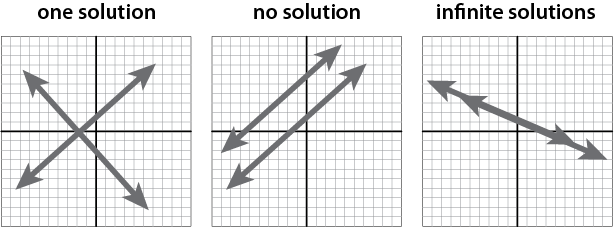Systems of Linear Equations
Systems of Linear Equations
Systems of equations are sets of equations that include two or more variables. These systems can only be solved when there are at least as many equations as there are variables.
The solution to the system is the set of values for each variable that satisfies every equation in the system. Graphically, this will be the values where lines intersect.
- If the lines intersect at one point, there is one solution.
- If the lines are parallel (hence, they do not intersect), the system will have no solution.
- If the lines are multiples of each other, meaning they share all coordinates, then the system has an infinite number of solutions because every point on the line is a solution.

There are three common methods for solving systems of equations: graphing, substitution, and elimination. To solve by graphing, rewrite each equation in slope-intercept form and graph each line individually. The graph will show if the system of equations has one solution, no solution, or infinitely many solutions.
To perform substitution, solve one equation for one variable; then, substitute the resulting expression for that variable into the second equation and solve for the variable.
Solve the system of equations:
2x – 4y = 28
4x – 12y = 36
Solve one equation for one variable.
2x – 4y = 28
x = 2y + 14
Substitute the resulting expression for x in the second equation, and solve for y.
4x – 12y = 36
4(2y + 14) – 12y = 36
−4y = −20
y = 5
Substitute y = 5 into either equation to find the value of x.
2x – 4y = 28
2x – 4(5) = 28
x = 24
The solution is (24, 5).
To solve using elimination, add or subtract two equations so that one or more variables are eliminated. It’s often necessary to multiply one or both equations by a scalar (constant) to allow the variables to cancel. Equations can be added or subtracted as many times as necessary to solve for each variable.
Solve the system of equations:
6x + 10y = 18
4x + 15y = 37
Multiply each equation so that the x variables have opposite coefficients.
−2(6x + 10y = 18) → −12x −20y = −36
3(4x + 15y = 37) → 12x + 45y = 111
Add the two equations to eliminate the x terms and solve for y.
25y = 75
y = 3
Replace y with 3 in either of the original equations.
6x + 10(3) = 18
6x = –12
x = –2
The solution is (–2, 3).
